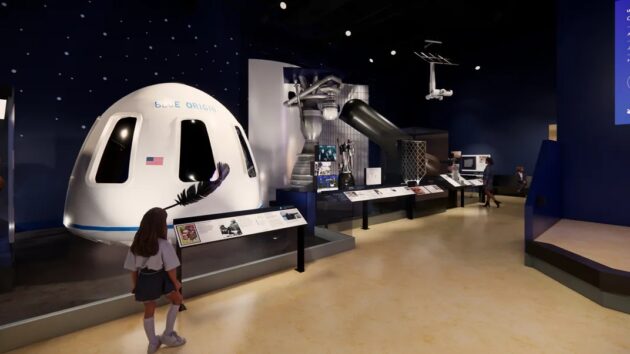Blue Origin donates historic New Shepard booster and space capsule to Smithsonian
Jeff Bezos’ Blue Origin space venture has donated a New Shepard rocket booster, plus a New Shepard capsule, to the Smithsonian’s National Air and Space Museum.
The history-making hardware will go on display at the museum’s main building on the National Mall in Washington, D.C., in renovated galleries due to open in 2026.
“There is no better final landing pad for New Shepard than the Smithsonian,” Bezos said in a statement. “We are honored and grateful.”
The reusable booster, known as Propulsion Module 4-2, was employed for five uncrewed flights — ranging from the New Shepard program’s first successful booster landing in 2015 to an escape system test that could have destroyed the propulsion module in 2016.
Before that final outing for the booster, Bezos said it would be put on display if it survived. “We’d really like to retire it after this test and put it in a museum,” he said at the time. “Sadly, that’s not likely. This test will probably destroy the booster.”
Fortunately for the Smithsonian, Bezos’ prediction was wrong. The scorched but intact booster was exhibited at a variety of events, including the 2017 Space Symposium in Colorado, and most recently was on display at Blue Origin’s New Glenn rocket factory in Florida.
Propulsion Module 4-2 is now being prepared for a spot in the National Air and Space Museum’s RTX Living in the Space Age Hall, which features Space Age artifacts going back to the mid-20th century.
“Rockets are the place where this all starts — that’s how we get to space in the first place,” Smithsonian Magazine quoted curator Colleen Anderson as saying. “They’re both in the physical center, but also the thematic center of this exhibit. So, for instance, we have a full-scale Juno 1 rocket, which launched Explorer 1, the first U.S. satellite. And if we put New Shepard next to it in the gallery, this allows us to extend the story of launch vehicles to the present.”
The donated Blue Origin crew capsule went into service after Propulsion Module 4-2 was retired, but it’s arguably just as historic. In 2021, the RSS First Step, with RSS standing for “Reusable Space Ship,” carried the first people to ride New Shepard to the edge of space and back. The crew included Bezos himself.
“I’m really excited about this object in particular, because RSS First Step has enabled 43 new astronauts to go into space over the period of three years,” curator Emily Margolis told Smithsonian Magazine. “And that’s a really big deal for those 43 people who might not have had pathways to space otherwise.”
RSS First Step is still in service, most recently to send a crew of six on a suborbital space trip in August. Now Blue Origin is getting a brand-new capsule capable of carrying humans, dubbed the RSS Karman Line, ready to join the New Shepard fleet.

When First Step is decommissioned, it’ll go on display in the National Air and Space Museum’s Futures in Space gallery, which focuses on advances in space exploration technology and enterprise. In the meantime, a full-scale mockup of the crew capsule will be exhibited in its place.
“Can’t wait for this exhibit and the impact it and other historic space artifacts will have on the millions of people who will visit and dream about their own space journeys,” Blue Origin CEO Dave Limp said in a posting to X / Twitter.
This isn’t the first time a Seattle-area billionaire has played a role in getting space artifacts to the Smithsonian. Hardware from Apollo 11’s Saturn V rocket was recovered from the bottom of the Atlantic Ocean in 2013 with funding from Bezos — and is now on display at the National Air and Space Museum. (Rocket components that Bezos’ team recovered from other Apollo missions are on view at Seattle’s Museum of Flight.)
Yet another piece of space history — the SpaceShipOne rocket plane that won the $10 million Ansari X Prize for private spaceflight in 2004 — was donated to the Smithsonian by Microsoft co-founder Paul Allen a year later. It’s now hanging next to Charles Lindbergh’s Spirit of St. Louis airplane in the National Air and Space Museum’s Milestones of Flight Hall. (SpaceShipOne’s mothership, known as the White Knight, is on display at the Flying Heritage & Combat Armor Museum at Paine Field in Everett, Wash.)

